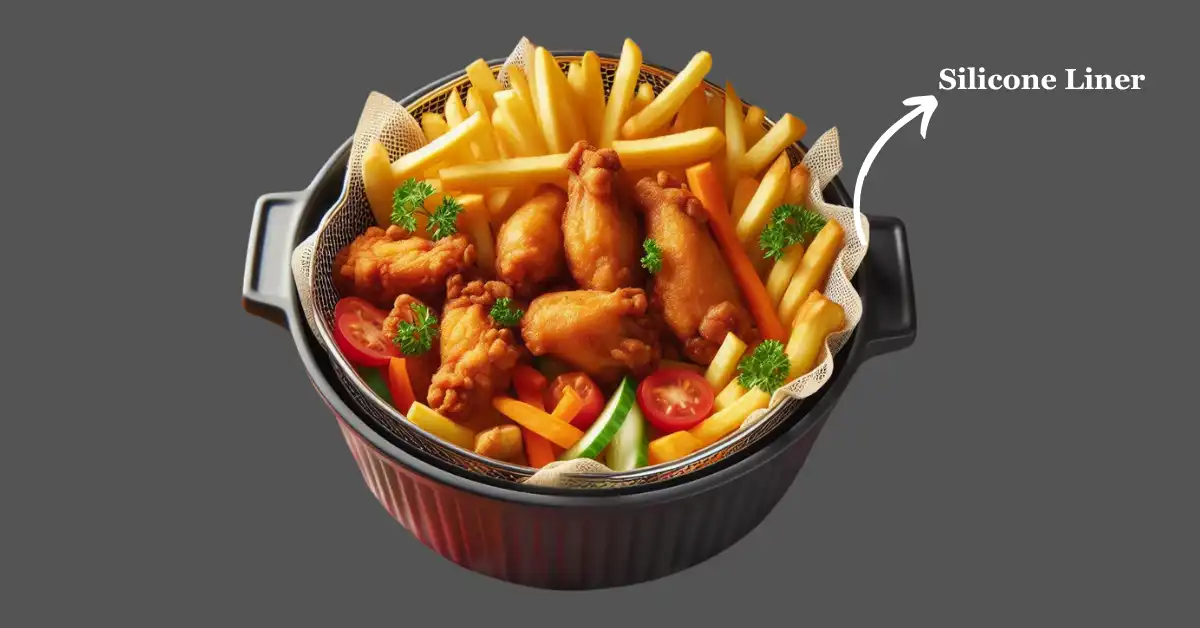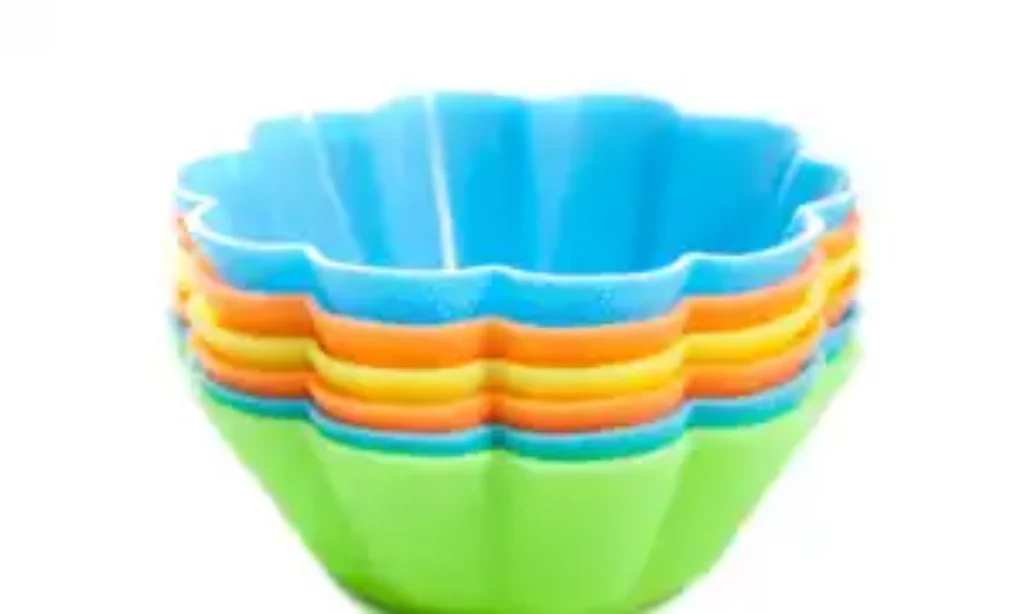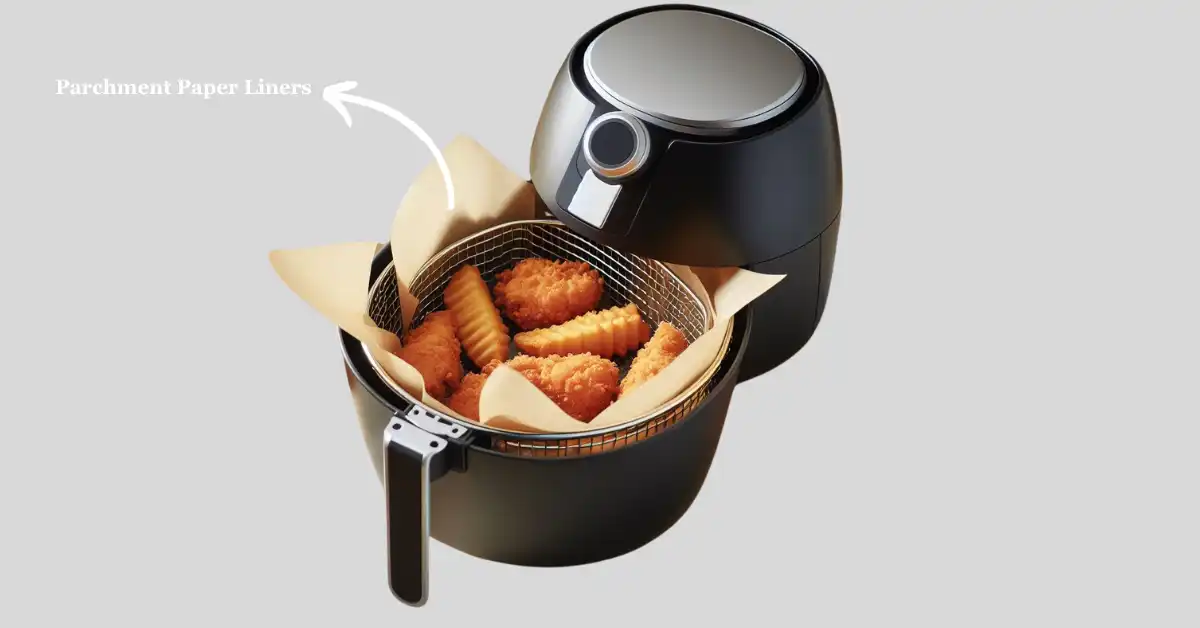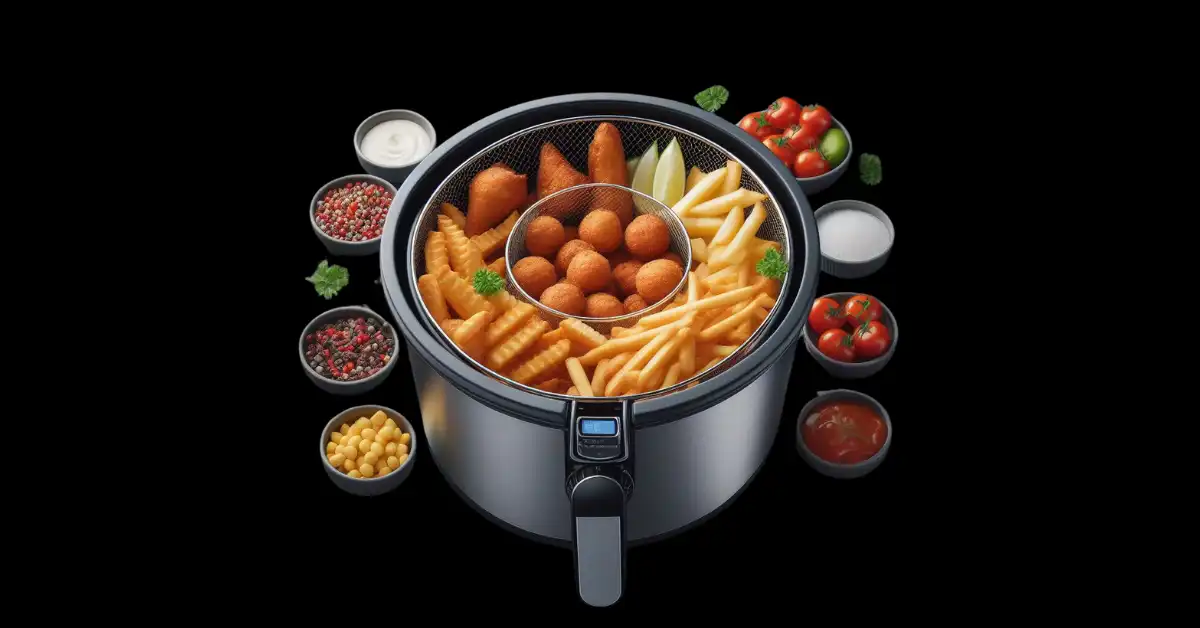In today’s health-conscious world, many of us are turning to air fryers as a way to enjoy our favorite fried foods with less oil and fewer calories. But with the convenience of air frying comes a question that’s been on many minds: “Are air fryer liners safe?”
The concern for safety, coupled with the desire to keep our air fryers clean and maintenance-free, has led us to explore this topic in depth. Through vigorous research and hands-on experiments, we’ve gathered compelling evidence and insights that will not only address your safety concerns but also enhance your air frying experience. Keep reading to discover everything you need to know about air fryer liners and make an informed decision on whether they’re right for your kitchen.
All About Are Air Fryer Liners Safe?
Air fryer liners are safe for cooking, as long as you use them correctly. These liners are designed to withstand high temperatures, meaning they won’t melt or cause harmful chemicals to leach into your food during the cooking process. It’s important, though, to choose liners that are specifically made for air fryers and are free of BPA and other harmful substances. The key to their safe use is ensuring they’re not blocking the air circulation within your air fryer, as this could lead to uneven cooking or potentially overheating. Always follow the manufacturer’s guidelines to ensure optimal safety and performance.
Discover the Ease of Air Fryer Cooking with Safe Liners
What Are Air Fryer Liners? Definition and Practical Uses
Air fryer liners are innovative kitchen accessories designed to make air frying an even more convenient and mess-free cooking method. Essentially, these liners act as a protective barrier between the food and the air fryer basket, ensuring that foods do not stick to the bottom, making cleanup a breeze. Available in materials like silicone and parchment paper, air fryer liners are crafted to withstand the high temperatures generated by air fryers, playing a crucial role in maintaining the integrity and flavor of your cooked meals.
The purpose of air fryer liners goes beyond just simplifying cleanup. They are also about preserving the quality of your air fryer basket by preventing scratches and wear from regular use. With these liners, the air fryer’s efficiency in circulating hot air around the food isn’t compromised, ensuring your dishes come out perfectly crispy and evenly cooked every time. Incorporating keywords such as “air fryer cooking,” “convenient cooking solutions,” and “kitchen accessories” can help highlight the ease and utility that these liners bring into the modern kitchen, making meal prep simpler and more enjoyable.
Ensuring Your Health with Air Fryer Liner Safety

The use of air fryer liners has been a game-changer in how we approach healthier cooking methods. They not only contribute to a less messy cooking experience but also raise questions about their safety profiles. Here, we’ll dissect the components that make up air fryer liners and evaluate their safety when subjected to high temperatures. This investigation aims to clear any doubts, ensuring you can continue enjoying the convenience of your air fryer without compromising on health.
Material Safety: What Are They Made Of?
Air fryer liners typically come in two main materials: parchment paper and silicone. Parchment paper liners are disposable, designed for single use, and are known for their natural, non-stick properties. They’re usually made from siliconized or quilon-coated paper, which can safely withstand the high heat of air fryers. Silicone liners, on the other hand, are reusable and boast a high degree of flexibility and durability. Made from food-grade silicone, these liners are BPA-free and do not release harmful substances when heated. Choosing liners made from these materials ensures that you are opting for a safe and environmentally conscious option for your air frying.
Heat Resistance and Chemical Stability
One of the paramount considerations for the safety of air fryer liners lies in their ability to resist high temperatures and maintain chemical stability during cooking. Parchment paper liners are generally safe up to temperatures of 420°F (215°C), which accommodates the majority of air frying recipes. Silicone liners offer even more versatility with a resistance of up to 450°F (232°C). Both materials maintain their structural integrity and do not decompose or emit harmful chemicals when used within these temperature ranges. It’s essential to verify the heat resistance of any air fryer liner you purchase and to use them within the specified temperature limits to ensure safety and optimal cooking results.
Exploring the Variety of Air Fryers and Their Compatible Liners
When it comes to cooking with air fryers, understanding the types available and choosing the right liners is essential for both optimal performance and safety. In this section, we’ll break down the different air fryer models and the compatible liners that ensure a seamless cooking experience.
Types of Air Fryers
- Basket Air Fryers: These are the most common type, known for their compact design and ease of use. Basket air fryers circulate hot air around the food in a removable basket, making them perfect for small to medium-sized meals.
- Oven-Style Air Fryers: Offering more versatility, these air fryers come with racks instead of baskets, allowing you to cook multiple food items simultaneously. They’re ideal for larger families or meal prep sessions.
- Paddle-Type Air Fryers: Equipped with a rotating paddle, these air fryers automatically stir the food, ensuring even cooking. They are fantastic for dishes that need continuous stirring, like risottos or stews.
Types of Air Fryer Liners
- Parchment Paper Liners: Designed for single use, these liners are perfect for basket and oven-style air fryers. They’re available in pre-cut shapes and sizes, ensuring a perfect fit and hassle-free cleanup.

- Silicone Liners: Reusable and eco-friendly, silicone liners are a flexible option for all air fryer types. Their heat-resistant property makes them safe for cooking, and they can easily be washed and reused.

- Perforated Aluminum Liners: These are less common but useful for specific recipes that require a bit more heat conductivity. It’s crucial to ensure they’re compatible with your air fryer model to avoid any safety risks.

Choosing the right type of air fryer and liner not only enhances your cooking experience but also ensures your meals are cooked safely and efficiently. With these insights, you’re equipped to make informed choices tailored to your cooking needs and preferences.
The Perfect Match: Best Liners for Different Air Fryer Models
Discovering the ideal liner for your air fryer can transform your cooking experience, making it smoother, cleaner, and safer. In this part of our comprehensive guide, we’ll explore which liners pair best with each type of air fryer. Our goal is to help you make a choice that’s not only practical but also optimizes your air frying sessions.
Best Liners for Basket Air Fryers
For those of you using basket air fryers, parchment paper liners are a fantastic choice. They are specifically designed to withstand high temperatures without sticking to your food or the air fryer basket. These liners are usually disposable, making cleanup a breeze. Just ensure that you choose the right size for your air fryer basket to allow proper air circulation.
Choosing Liners for Oven-Style Air Fryers
If you own an oven-style air fryer, you’ll appreciate the versatility of silicone liners. These liners are durable, reusable, and can easily handle the varying temperatures of oven-style air fryers. They fit nicely on the racks, and due to their flexibility, they can adapt to different sizes and shapes, making them ideal for cooking a variety of dishes.
Optimal Liners for Paddle-Type Air Fryers
For those with paddle-type air fryers, the constant movement within the appliance might seem limiting in terms of liner options. However, silicone liners are again the best choice here due to their durability and flexibility. They can withstand the moving parts of the air fryer and offer a non-stick surface that’s perfect for dishes that require constant stirring.
Each type of air fryer has its unique requirements, and matching it with the right liner can enhance the flavor of your food, reduce cleaning time, and ensure a safer cooking process. Whether you opt for parchment, silicone, or another type of liner, make sure it’s suitable for your specific air fryer model and cooking needs.
Unlocking the Safety and Convenience of Air Fryer Liners
When pondering the question, “Are air fryer liners safe?” it’s essential to understand their multitude of benefits. Air fryer liners are not just safe; they elevate your cooking experience by prioritizing health, safety, and convenience. Here’s how:
- Health Benefits: Air fryer liners act as a barrier between your food and the fryer basket, minimizing direct contact. This reduces the risk of harmful substances contaminating your food, making every meal healthier.
- Enhanced Safety: By using liners designed to withstand high temperatures without melting or releasing toxins, you ensure that your cooking environment is safe. They prevent food from sticking to the air fryer basket, which can cause overheating and potentially dangerous situations.
- Simplified Cleaning Process: Perhaps one of the most celebrated advantages is the ease of cleanup. Liners catch drippings and crumbs, preventing them from burning onto the basket. Once you’re done cooking, simply remove and dispose of or wash the liner, depending on the type.
- Consistency in Cooking: Liners promote better air circulation around the food, ensuring even cooking. This means your meals come out perfectly crispy and well-cooked every single time, enhancing the overall flavor and texture.
- Environmental Impact: The use of reusable silicone liners aligns with sustainable living practices. By opting for these eco-friendly alternatives, you’re not only making a safe choice for your health but also doing your part for the environment.
Navigating the Downsides of Air Fryer Liners
While air fryer liners bring numerous benefits to your kitchen experience, understanding their potential disadvantages is equally important. Being informed can help you make the most out of your air frying while avoiding common pitfalls.
- Blocked Air Flow: One key principle of air frying is the free circulation of hot air around the food. Using liners that are too large or improperly placed can block this airflow, leading to uneven cooking or longer cooking times. Always ensure the liner fits well and does not cover the sides of the basket.
- Cost Over Time: For those using disposable parchment paper liners, the cost can add up over time. Although individually inexpensive, regular use can become a recurring kitchen expense. Considering reusable options like silicone liners can be a more cost-effective solution in the long run.
- Environmental Concerns: Disposable liners, while convenient, generate additional waste. For eco-conscious individuals, this aspect might outweigh the convenience. Opting for reusable liners can mitigate this issue, aligning better with sustainable living practices.
- Compatibility Issues: Not all liners are suitable for every type of air fryer. Using the wrong type of liner, such as aluminum in a model where it’s not recommended, can pose safety risks. Always check the compatibility of the liner with your specific air fryer model.
- Tendency to Catch Wind: Lightweight liners or parchment paper can sometimes get caught in the powerful airflow of the air fryer and could wrap around or stick to the food. This can be prevented by ensuring the liner is weighed down properly with food and not used when cooking very light or small items.
Mastering Air Fryer Liners for Healthy, Effortless Meals

Learning how to use air fryer liners safely is key to unlocking the full potential of your air fryer, transforming it into a tool for creating healthy, delicious, and effortless meals. Choosing the right liner for your air fryer model isn’t just about convenience; it’s about ensuring that every dish you cook is both safe to eat and easy to clean up afterward. Here’s your guide to making the most out of these handy kitchen accessories:
Choosing the Right Liner for Your Air Fryer Model
Each air fryer’s design demands a specific type of liner to optimize its functionality. Basket air fryers work best with parchment paper liners, designed to resist high heat without interfering with the device’s cooking efficiency. Oven-style air fryers, on the other hand, benefit from the durability and reusability of silicone liners. For paddle-type air fryers, silicone liners again prove superior due to their robustness and flexibility. Ensuring compatibility with your air fryer’s model guarantees not just a perfect fit but also ideal cooking results.
Proper Placement and Usage Tips
Proper placement is crucial to maximize the benefits of using air fryer liners. Here are a few tips to help you use them safely and effectively:
- Ensure Proper Fit: Never force a liner to fit; it should lay flat at the bottom of the basket or tray without covering the sides. It’s crucial for maintaining the air flow that makes air frying so efficient.
- Avoid Overlap: When using a liner, make sure it does not fold or overlap. This can restrict air flow leading to uneven cooking.
- Weigh It Down: To prevent the liner from getting sucked up into the heating element, always place food directly on top of it. This is especially important when cooking lighter items.
- Heat Resistance: Always check the liner’s maximum heat resistance and never exceed it. This will prevent the material from melting or causing any harmful emissions.
- No Preheating with Empty Liners: Avoid putting liners in the air fryer during preheating if there’s no food to hold them down, as they might fly up and come in contact with the heating element.
By carefully selecting and using air fryer liners, you can enhance the safety, efficiency, and cleanliness of your cooking. Whether you’re aiming for healthier meals, a quicker cleanup, or just an overall more pleasurable cooking experience, taking these small steps will ensure your air frying adventures are successful on all fronts.
Exploring Eco-Friendly Alternatives to Disposable Air Fryer Liners
Disposable liners, while offering convenience at your fingertips, aren’t the greenest choice for our planet. The ease of simply tossing them out after use contributes to the growing concern of waste in our environment. For those of us striving to lead a more sustainable lifestyle, it’s important to recognize that every small action counts towards a larger impact. While disposable parchment paper liners might seem like a minor contributor to waste, their regular use accumulates over time, making them less eco-friendly than they appear. Choosing reusable options like silicone liners not only decreases waste but also promotes a cycle of reuse that is beneficial for our planet. By making the switch, we not only support our environment but also inspire others to consider their usage and the alternatives available.
Optimal Foods for Air Fryer Liners & Those to Avoid
The Best Foods to Cook with Air Fryer Liners
Cooking with air fryer liners can transform your kitchen experience, making it cleaner and more efficient. Ideal for use with foods that are prone to sticking or leaving residue, liners particularly shine when used with breaded items such as chicken tenders, fish sticks, and vegetable fritters. These foods benefit from the non-stick surface, ensuring they cook evenly without tearing apart. Snacks like frozen French fries or tater tots also cook wonderfully on liners, as they prevent smaller pieces from falling through the basket and allow for easy clean-up. Delicate foods, such as homemade cookies or small pastries, greatly benefit from liners, as they provide a smooth surface that preserves the integrity of the food’s shape and design.
Foods to Cook Without Air Fryer Liners
While liners serve as helpful accessories in many cooking scenarios, there are certain foods where their use is not recommended. Foods that require direct exposure to the air fryer’s circulating heat for optimal crispiness, such as steak or skin-on chicken thighs, should be cooked directly in the basket. Using liners with these foods can inhibit the airflow necessary for achieving that desired exterior crisp while keeping the inside juicy. Additionally, very lightweight or leafy vegetables, like kale chips or spinach, might not fare well with liners as they can easily be disturbed by the air fryer’s powerful fan, potentially leading to uneven cooking or the liner itself displacing and causing a mess.
By understanding which foods are suitable and which are not for air fryer liners, you can leverage these kitchen tools to enhance your cooking experience, ensuring delicious results while keeping cleanup to a minimum.
Upgrade Your Cooking Experience with Air Fryer Liners
Using air fryer liners can significantly elevate your cooking game, making it not only cleaner but also more efficient and enjoyable. These liners, available as disposable parchment or reusable silicone options, are designed to fit neatly into your air fryer’s basket or tray, creating a non-stick surface that’s perfect for a wide array of foods. By preventing sticking and ensuring an even heat distribution, liners make it easier than ever to achieve perfectly cooked meals. Whether you’re whipping up a batch of crispy chicken tenders or baking delicate homemade cookies, air fryer liners ensure your food cooks evenly, retains its integrity, and releases without a hitch. Beyond the immediate benefits to your meals’ quality and presentation, liners also simplify clean-up, allowing you to spend less time scrubbing and more time enjoying your culinary creations. In short, integrating air fryer liners into your cooking routine is a simple step that can bring about a significant upgrade to your overall experience in the kitchen.
Why Cutting and Punching Holes in Your Air Fryer Liner is a Game-Changer
One critical aspect often overlooked when using air fryer liners is the need to customize their fit and functionality. Trimming and perforating your air fryer liner might sound like extra steps, but they’re essential for maximizing the efficiency of your cooking. By trimming the liner to fit your air fryer’s basket, you ensure that airflow isn’t unnecessarily blocked. Air flow is key in air frying, as it’s what gives food that coveted crispiness. Similarly, punching small holes in the liner further facilitates this circulation. While liners are designed to make clean-up a breeze and prevent sticking, without adequate air flow around your food, you might end up with soggy or unevenly cooked dishes. Thus, taking a moment to cut to size and add perforations to your liner will elevate your air frying game, ensuring that every meal is as delicious as intended.
Troubleshooting Common Issues with Air Fryer Liners
When using air fryer liners, some users might encounter a few hiccups along the way. However, most of these issues can be easily resolved with a bit of know-how. A common problem is liners flying up into the heating element due to the air fryer’s strong fan. This can be avoided by making sure the liner is always weighed down with food before starting the air fryer. Another issue is food sticking to the liner, which usually means it might not be compatible with very sticky foods, or you may need to lightly grease the liner before use. Additionally, if you find your food isn’t cooking evenly, it could be due to incorrect placement or size of the perforations in your liner. Ensuring your liner is properly perforated and placed will help maintain optimal air flow, necessary for evenly cooked dishes. Addressing these common troubles will help you enjoy the full benefits of air fryer liners, making your cooking experience smoother and more enjoyable.
Conclusion: The Benefits and Safety of Air Fryer Liners
In conclusion, air fryer liners offer a practical solution for making air frying cleaner, more efficient, and enjoyable. Beyond the convenience they provide, many consumers might wonder, “are air fryer liners safe?” The answer is a resounding yes, as long as they’re used correctly. These liners are designed to withstand the high heat of air fryers and, when properly perforated and weighted down with food, they pose no risk of flying up into the heating element or interfering with the cooking process. By choosing the right type of liner—whether disposable parchment or reusable silicone—and ensuring it fits well within your air fryer with appropriate perforations for airflow, you can maximize the crispiness and flavor of your dishes without compromising on safety.
Our final recommendation is to incorporate air fryer liners into your cooking repertoire, not only for their non-stick convenience and easy cleanup but also for the peace of mind they offer. Remember to select liners that are compatible with your air fryer model, and customize them as needed for optimal airflow and cooking results. With these tips, air fryer liners can significantly enhance your culinary experience, allowing you to enjoy your favorite fried foods with less oil, mess, and hassle.

